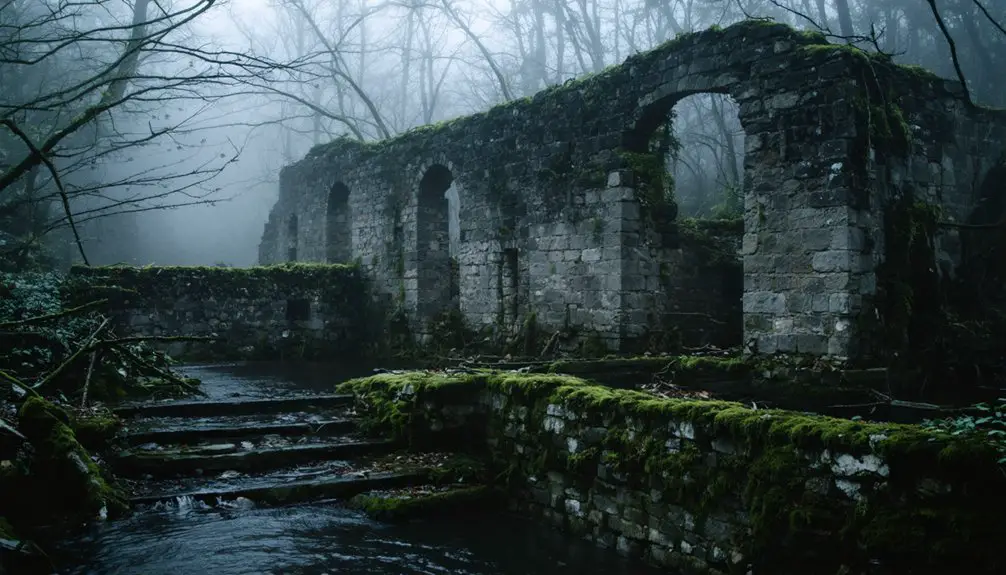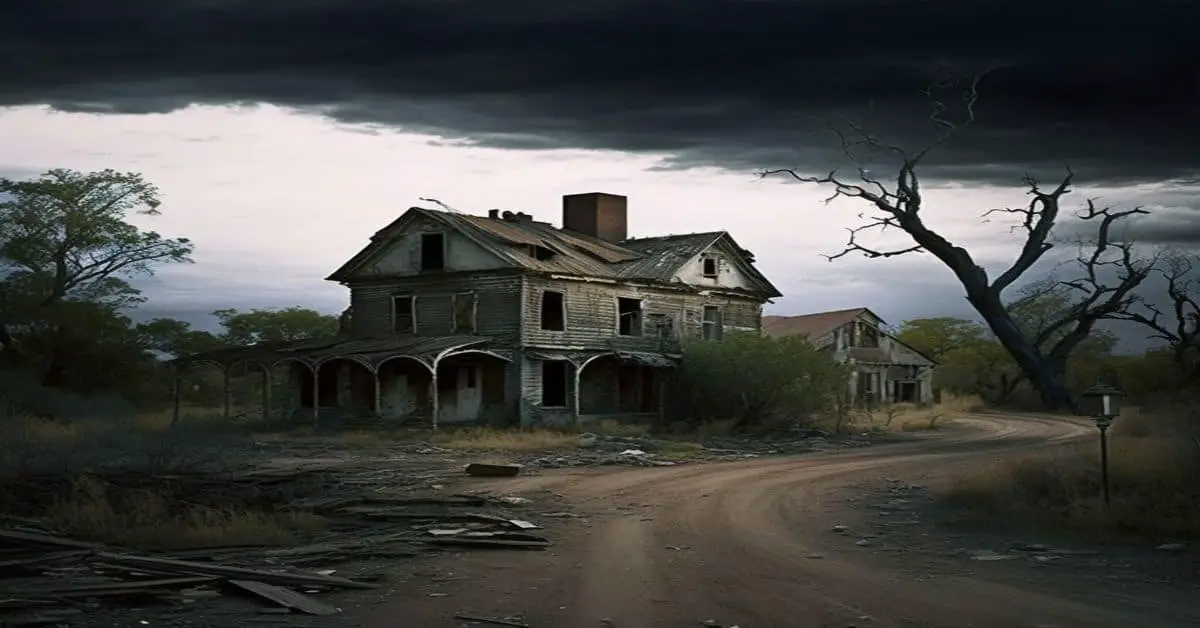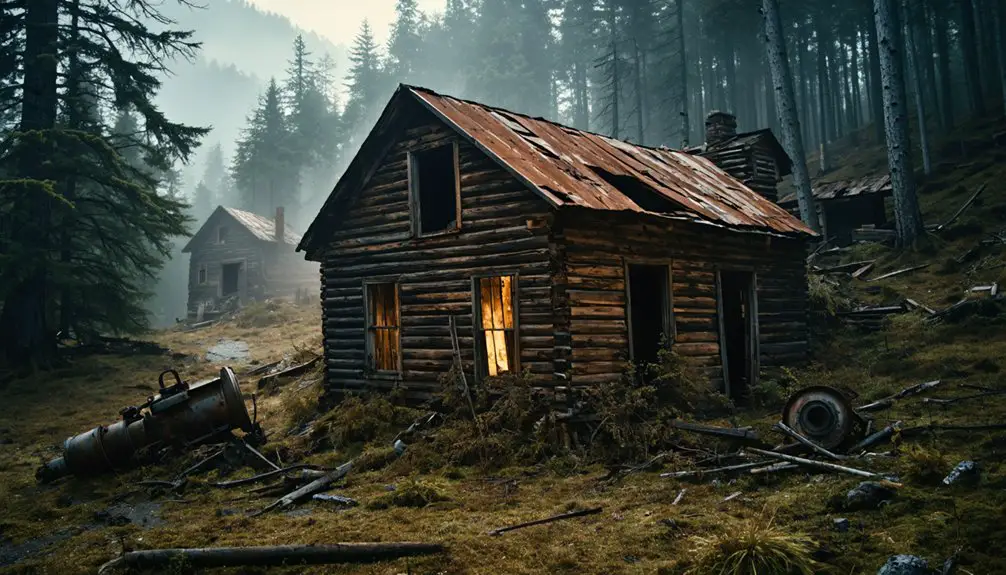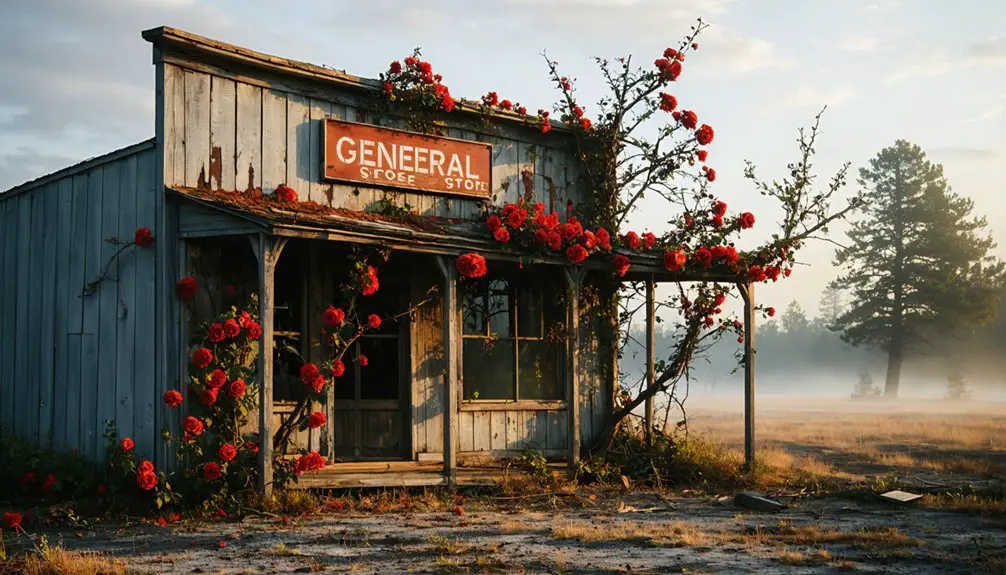You’ll discover Selbysport’s remnants in Garrett County, Maryland, at 452 meters elevation (39°41′11″N, 79°22′49″W). This former industrial town flourished with lumber mills, tanneries, and the B&O Railroad until 1944, when Yough Lake Reservoir’s flooding submerged much of the settlement. Today, you can explore the historic Mercy Chapel, listed on the National Register since 1984, along with train trestle ruins and old cemeteries that tell a deeper story of this Appalachian community.
Key Takeaways
- Selbysport was a Maryland town at 452 meters elevation that became submerged by Yough Lake Reservoir flooding in 1944.
- The ghost town’s historic Mercy Chapel, built in 1874, remains preserved and listed on the National Register of Historic Places.
- Economic decline followed the flooding, with residents relocating to urban areas after losing farmland and natural resources.
- Archaeological remnants include railroad trestle supports, furnace ruins, and church ruins listed as Maryland Historical Trust site G-II-A-027.
- Tropical Storm Agnes in 1972 damaged remaining structures, leaving only cemetery grounds and church ruins as visible historical markers.
Location and Early Settlement History
Nestled in the western reaches of Maryland’s Garrett County, Selbysport stands at an elevation of 452 meters within the Appalachian region.
You’ll find this unincorporated community at 39°41′11″N latitude and 79°22′49″W longitude, surrounded by the mixed forests and farmlands characteristic of the area’s rugged terrain.
The settlement patterns of Selbysport followed the westward expansion typical of 19th-century Maryland.
Early agriculture drove the community’s development, with pioneers establishing homesteads near Mill Run for water access.
Modern GPS technology places Selbysport in UTM zone 17S, providing precise coordinates for mapping and navigation.
The area’s first residents capitalized on available natural resources, engaging in farming and small-scale logging operations.
Their community grew around Mercy Chapel, which served as an essential gathering place and remains listed on the National Register of Historic Places since 1984.
The National Park Service maintains detailed records of the area’s historical significance since 2008.
The Rise of Industry and Commerce
The industrial development of Selbysport took root alongside the early agricultural settlements, with lumber milling emerging as the area’s primary economic driver.
You’ll find that the timber economy shaped the region’s industrial transformation, starting with Philip Hare’s sawmill near Grantsville in 1790. W.W. Griffith’s sawmill on Bear Camp Run later exemplified the area’s reliance on water power, using turbines to process timber.
When the B&O Railroad arrived, it connected Selbysport’s industries to broader markets, spurring growth in sawmills, tanneries, and barrel stave manufacturing. The rich iron ore deposits found throughout Garrett County attracted additional industrial development to the region.
The town’s strategic position near both rail lines and the Youghiogheny River system helped local businesses thrive, while tanneries utilized abundant forest resources for bark and hides, creating a diverse industrial base that supported workers throughout western Maryland.
From Tannery Town to Ghost Town
During the mid-20th century, Selbysport’s transformation from bustling industrial center to ghost town accelerated dramatically when the Yough Lake Reservoir flooded significant portions of the settlement in 1944.
You’ll find that this flooding marked a turning point in the town’s economic decline, submerging crucial farmland and forcing widespread community displacement. Like the Town of Daniels, this community’s fate was sealed by devastating flooding that destroyed vital infrastructure.
The natural resource depletion in the region contributed significantly to the town’s downfall, as local industries struggled to remain viable.
As industrial shifts reshaped the region’s economy, you can trace how Selbysport’s residents gradually relocated to urban centers with more stable job prospects.
The loss of railway connectivity dealt another blow, effectively ending the town’s role as a commercial hub.
Today, you’ll discover only remnants of the original railroad trestle supports and scattered ruins near the former town site, while the surrounding area has been repurposed into recreational trails that preserve the memory of this once-thriving community.
Preserving the Past: Mercy Chapel at Mill Run
While much of Selbysport’s industrial heritage succumbed to flooding and abandonment, Mercy Chapel at Mill Run stands as a remarkable architectural survivor from the town’s more prosperous era.
You’ll find this one-story Carpenter Gothic gem perched on a slight rise within a wooded clearing, where it’s served the community since 1874.
The chapel’s octagonal design makes it truly special – it’s the only 19th-century octagonal building in Garrett County and one of Maryland’s most sophisticated examples of this rare architectural form.
Listed on the National Register of Historic Places since 1984, the building’s virtually unchanged interior showcases local craftsmanship from the 1870s. The chapel was designed by architect John Miller, who incorporated distinctive elements of the Carpenter Gothic style.
Two small graveyards flank the chapel, reflecting its deep ties to community life and architectural preservation efforts in Western Maryland. Recent documentation shows 90 percent photographed of the burial sites have been digitally preserved for future generations.
Life in the Appalachian Industrial Era
As railroads carved through Maryland’s Appalachian region in the late 1800s, Selbysport emerged as a quintessential company town where life revolved around industrial development. Similar to nearby coal mining settlements in Garrett County, the town relied heavily on natural resource extraction.
You’d have found yourself living in company-owned housing, working long hours in mills or mines, and shopping at company stores. Despite labor struggles, you could’ve experienced strong community cohesion through shared experiences at places like St. Albin’s Episcopal Church or local recreational spaces.
Like in many industrial towns, residents faced harsh realities including exploitative child labor practices that were common during this era. Many families supplemented their factory wages by maintaining gardens and livestock, selling heavy cream to nearby markets. Your daily routine would’ve centered around the railroad’s schedule, factory whistles, and church bells that marked time in this close-knit industrial community.
The town’s rhythm continued until 1944, when the creation of Yough Lake submerged much of Selbysport’s industrial heritage.
Modern-Day Remnants and Cultural Legacy
Today’s remnants of Selbysport tell a story of gradual decay, with most original structures demolished after the mill’s 1968 closure.
Abandoned since 1968, Selbysport’s crumbling ruins stand as silent witnesses to a once-thriving mill town’s slow fade into history.
You’ll find only the church ruins and an overgrown cemetery standing as silent witnesses to the town’s past. Tropical Storm Agnes in 1972 further ravaged what little remained.
Archaeological findings reveal the town’s significance through surviving train trestle supports and nearby furnace ruins, now listed as Maryland Historical Trust site G-II-A-027.
Community memory lives on through local cemeteries that preserve the names of original settlers and veterans. The creation of Yough Lake Reservoir in 1944 submerged much of the original township.
While the Smithsonian once considered preserving the site, Selbysport’s legacy now primarily exists in regional recreation development.
You can trace its history along planned hiking trails that incorporate the old railway infrastructure, blending cultural heritage with modern outdoor activities.
Frequently Asked Questions
What Is the Current Population of Selbysport?
You’ll find zero permanent residents in Selbysport today, despite its historical significance. Current demographics confirm it’s a ghost town, though you might spot occasional visitors exploring its abandoned remnants.
Are There Any Guided Tours Available of Selbysport’s Historic Sites?
You won’t find regular guided tour options at Selbysport currently. While the area holds historical significance, you’ll need to arrange private tours or explore independently through local historical societies.
Can Visitors Legally Explore Abandoned Buildings in Selbysport?
While urban exploration beckons with mystery, you can’t legally enter abandoned buildings without explicit permission from property owners. Trespassing laws are enforced, regardless of the structures’ deteriorating state.
What Lodging Options Exist Near Selbysport for History Tourists?
You’ll find historic inns like Nemacolin Resort and Suites at Silver Tree, plus budget motels near Deep Creek Lake. Local campgrounds offer authentic outdoor stays while exploring Selbysport’s abandoned remnants.
When Was the Last Operating Business in Selbysport Closed?
Ever wonder about Selbysport history’s final chapter? You’ll find the last operating business was Engle’s Mill, which closed its doors in 1929, marking the end of commercial activity in this once-bustling town.
References
- https://msa.maryland.gov/megafile/msa/speccol/sc4300/sc4300/000005/000000/000007/unrestricted/garrett county mill chapter.pdf
- https://en.wikipedia.org/wiki/List_of_ghost_towns_in_Maryland
- https://friendsville.org/historytour/?page_id=483
- http://www.heritage.umd.edu/chrsweb/associatedprojects/chidesterreport/Chapter VIII.htm
- https://en.wikipedia.org/wiki/Selbysport
- https://latitude.to/articles-by-country/us/united-states/192880/selbysport-maryland
- https://www.mindat.org/feature-4369129.html
- https://maryland.hometownlocator.com/md/garrett/selbysport.cfm
- https://edits.nationalmap.gov/apps/gaz-domestic/public/gaz-record/587265
- https://www.baltimorecountymd.gov/files/Documents/Planning/historic/Bibliography of Western MD Industry.pdf



